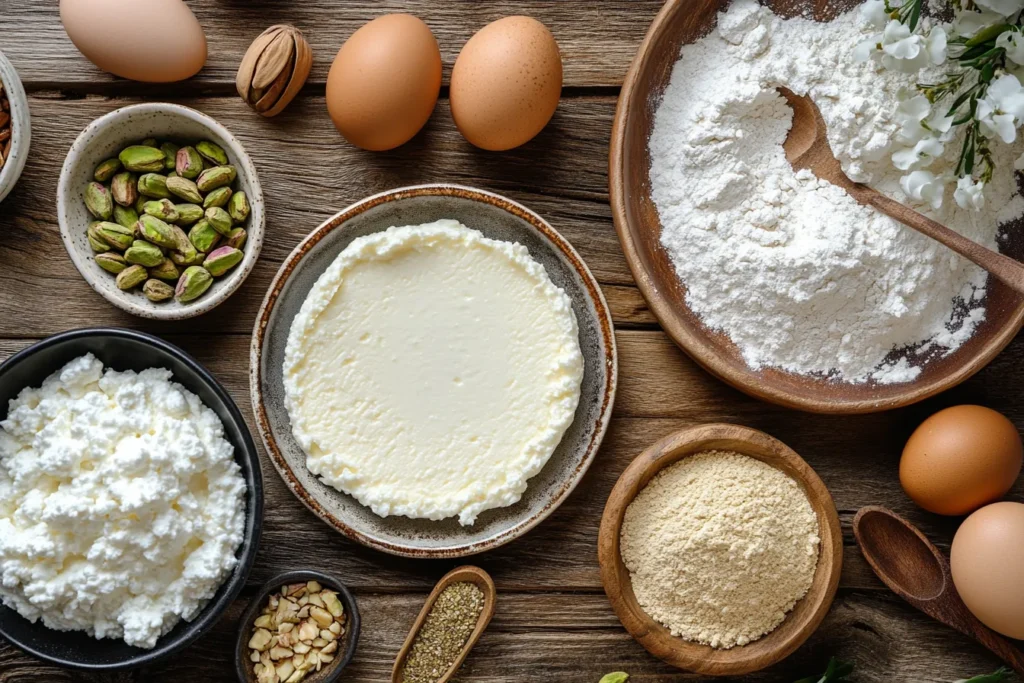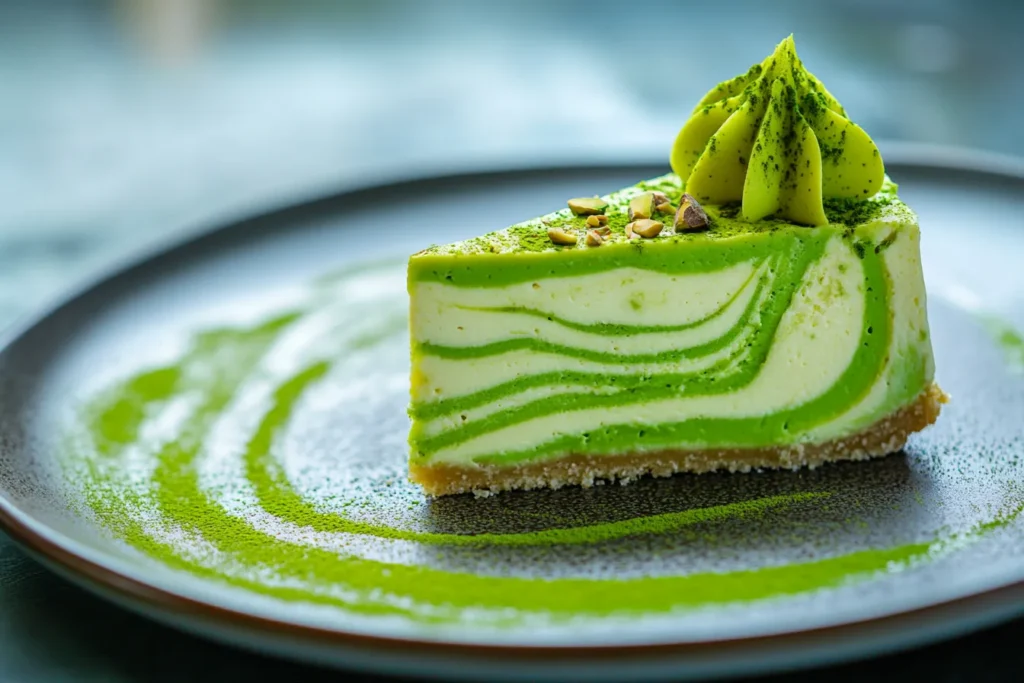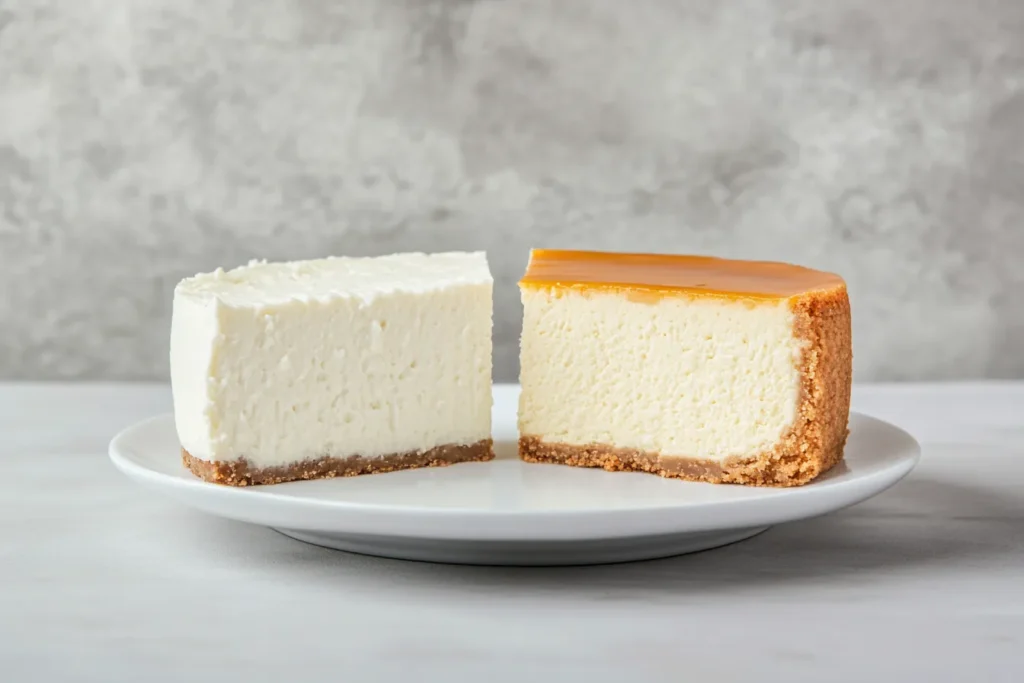Introduction
If you’re searching for a dessert that’s creamy, satisfying, and surprisingly good for you, this High Protein Pistachio Cottage Cheese Cheesecake is about to become your new obsession. Packed with muscle-building protein, nourishing healthy fats, and all the comforting flavor of traditional cheesecake, this innovative dessert hits all the right notes.
As people grow more health-conscious, recipes like this one—delicious yet nutrient-dense—are trending on platforms like TikTok and Pinterest. In fact, this high-protein dessert trend is dominating search results thanks to its perfect balance of indulgence and nutrition. Whether you’re looking to support your fitness goals, enjoy a low-sugar treat, or impress guests with a healthy twist, this pistachio cottage cheese cheesecake does it all..Banana Oat Bars
But why is this recipe taking the internet by storm?
- It’s high in protein but low in sugar.
- It swaps traditional cream cheese with cottage cheese, offering extra nutrition.
- It includes pistachios, rich in antioxidants and flavor.
- It can be made keto, low-carb, or even gluten-free with a few simple tweaks.
Before we jump into the step-by-step recipe, let’s explore why this dessert deserves a permanent place in your healthy recipe collection.
What Makes It High-Protein?
Cottage Cheese – A Protein Powerhouse
The magic starts with cottage cheese. Unlike traditional cheesecake that relies heavily on cream cheese (which is higher in fat but lower in protein), cottage cheese delivers a major protein upgrade. One cup of cottage cheese provides around 25g of protein, making it a muscle-building superstar for fitness enthusiasts and dieters alike..Caramelized Peaches
What’s even better? Cottage cheese blends smoothly in food processors, creating that familiar creamy texture you’d expect in a classic cheesecake. When baked, it firms up without compromising on richness or flavor.
Pistachios – Nutty Flavor and Nutrients
Pistachios don’t just offer a delicious nutty crunch—they’re also packed with plant-based protein, healthy fats, and fiber. With around 6g of protein per ounce, they add even more nutrition to your cheesecake while boosting satiety and enhancing texture.
They also contain antioxidants, vitamin B6, and potassium, making them a fantastic heart-healthy and metabolism-supporting addition.

Benefits of This Dessert
Muscle Recovery & Growth
Thanks to its high protein content, this cheesecake can actually serve as a post-workout snack. Protein plays a key role in muscle repair and growth, and combining dairy and plant protein sources provides a full amino acid profile.
Weight Management
Unlike sugar-heavy cakes that spike blood sugar, this recipe is low-GI, helping to control cravings and reduce hunger. Protein and healthy fats work together to keep you fuller for longer, making it easier to stay on track with your wellness goals..Cottage Cheese Chocolate Pudding
Nutrient-Rich Ingredients
Each ingredient in this recipe serves a purpose:
- Cottage cheese: protein, calcium, vitamin B12
- Pistachios: fiber, protein, heart-healthy fats
- Almond flour (optional crust): vitamin E, magnesium, low-carb
That’s why this isn’t just a dessert—it’s a smart nutritional choice disguised as a treat.
Ingredients You’ll Need
Core Ingredients
Let’s break down what goes into this incredible cheesecake:
Cottage Cheese
Use full-fat or low-fat based on your preferences. For the creamiest texture, make sure it’s blended smooth.
Pistachios
Shelled and either lightly roasted or raw. Keep a few chopped for topping.
Eggs, Sweetener, Almond Flour Base
Eggs help bind everything together. For sweetener, you can go for monk fruit, erythritol, stevia, or classic cane sugar if you don’t mind a few extra carbs.
The crust is optional, but almond flour with a touch of coconut oil or butter makes a perfect low-carb base.
Optional Enhancements
Vanilla Extract, Greek Yogurt, Lemon Zest
To enhance flavor, add a splash of vanilla extract. Some versions include Greek yogurt for creaminess or a bit of lemon zest for zing.

Step-by-Step Recipe Guide
Ready to create this creamy, protein-packed dessert? Follow these simple steps to make your High Protein Pistachio Cottage Cheese Cheesecake from scratch. This version is ideal for a 9-inch springform pan and yields 8–10 slices.
Preparation: Prepping and Mixing
Here’s what you’ll need:
Ingredients:
- 2 cups full-fat cottage cheese
- 2 large eggs
- ½ cup shelled pistachios (plus more for topping)
- ¼ cup Greek yogurt (optional, for creaminess)
- ⅓ to ½ cup sweetener of choice (monk fruit, erythritol, maple syrup, etc.)
- 1 tsp vanilla extract
- Zest of 1 lemon (optional)
- Pinch of salt
- Optional crust:
- 1 cup almond flour
- 2 tbsp melted butter or coconut oil
- 1 tbsp sweetener
Instructions:
- Preheat oven to 325°F (163°C). Lightly grease your springform pan.
- If using a crust:
- Mix almond flour, sweetener, and melted butter in a bowl until crumbly.
- Press into the bottom of the pan to form a thin crust.
- Bake for 8 minutes, then cool.
- In a food processor or high-speed blender, combine the cottage cheese and Greek yogurt. Blend until completely smooth—no lumps should remain.
- Add in eggs, sweetener, vanilla extract, lemon zest, and salt. Blend again until fully combined.
Baking Instructions
Water Bath Technique
To prevent cracks and create that smooth, creamy texture, bake your cheesecake in a water bath (bain-marie):
- Wrap the outside of your springform pan with aluminum foil (to prevent leakage).
- Place it in a larger baking dish and pour hot water into the outer dish until it reaches halfway up the sides of your pan.
Now bake for 45–55 minutes, or until the center is slightly jiggly but edges are firm. Don’t overbake—it will continue to set as it cools.
Cooling and Serving
- Let it cool in the oven (turned off, door cracked open) for about an hour.
- Move it to the fridge for at least 4 hours or overnight.
- Before serving, top with chopped pistachios, a drizzle of sugar-free honey, or a dollop of Greek yogurt.
This cheesecake pairs beautifully with herbal teas, almond milk lattes, or just on its own as a guilt-free dessert.
Nutritional Breakdown
What makes this cheesecake even more appealing is its macronutrient profile.
| Nutrient | Per Slice (approx.) |
|---|---|
| Calories | 180–220 kcal |
| Protein | 15–20g |
| Carbs | 6–10g (depending on sweetener) |
| Fat | 10–14g |
| Sugar | 2–5g (or less with low-carb options) |
Macro Comparison vs Traditional Cheesecake
Let’s compare with a slice of traditional cheesecake:
| Nutrient | Traditional | This Recipe |
|---|---|---|
| Calories | ~400 kcal | ~200 kcal |
| Protein | 5g | 18g |
| Carbohydrates | 30g+ | 8g |
| Sugar | 20g | 3g |
| Fat | 30g | 12g |
As you can see, the protein content is nearly tripled, while sugar and calories are cut by more than half.
This makes it an ideal treat for:
- Keto dieters
- High-protein meal planners
- Low-sugar lifestyles
- Post-workout snacks
Whether you’re counting macros, managing blood sugar, or just looking to eat cleaner, this dessert supports your goals.
Tips & Variations
One of the best parts about this High Protein Pistachio Cottage Cheese Cheesecake is its versatility. You can tweak ingredients, flavors, and presentation to suit your preferences, diet, or mood without sacrificing nutrition or taste.
Pudding-Style vs Classic Cheesecake Texture
- Pudding-like Cheesecake: If you prefer a soft, creamy, almost mousse-like texture, use Greek yogurt along with the cottage cheese and bake at a slightly lower temperature (around 300°F). Don’t overbake; let it set in the fridge overnight.
- Firm New York-Style Texture: For a firmer cheesecake, drain any excess liquid from your cottage cheese before blending. Add an extra egg to help with structure, and bake for the full 55 minutes.
Flavor Twists: Matcha, Berry, Chocolate Swirl
Feeling adventurous? Here are a few ways to remix this cheesecake:
- Matcha Pistachio: Add 1 tbsp of high-quality matcha powder to the batter. The earthy flavor pairs well with pistachios and gives a vibrant green hue.
- Berry Bliss: Swirl in a sugar-free raspberry or blueberry jam before baking. It adds a tangy contrast that complements the creamy base.
- Chocolate Pistachio Swirl: Melt 2 tbsp dark chocolate and swirl it into the batter for a marbled effect.
Each variation can be made with the same high-protein foundation while adding a delicious new twist.
Almond vs Graham Cracker Crust
For those who like a traditional base, you can replace the almond flour crust with crushed graham crackers mixed with melted butter. However, this will add more carbs and less protein, so it may not suit keto or low-carb diets.
Want to go crustless? Skip it entirely—just make sure to grease your pan well.

Troubleshooting Common Issues
Even a healthy cheesecake can have issues during baking. Here’s how to avoid or fix them:
Cracks on the Surface
Cracks happen when the cheesecake is overbaked or cooled too quickly. To prevent this:
- Always use a water bath.
- Let the cheesecake cool gradually in the oven with the door cracked.
- Don’t overmix the eggs; too much air can cause the cheesecake to puff and crack.
If you do get cracks, don’t worry—top it with crushed pistachios, Greek yogurt, or a light drizzle of honey to cover them.
Sinking in the Middle
This usually happens when the center is underbaked or collapses during rapid cooling. Use the toothpick test—when it comes out mostly clean with a slight jiggle in the center, it’s done.
Also, avoid opening the oven too early while baking, as temperature fluctuations can cause the middle to sink.
Grainy Texture
If your cheesecake feels grainy, the cottage cheese might not have been blended long enough. Always blend until smooth and strain if needed for a silkier texture.
Storing, Freezing & Reheating
Let’s talk longevity—this cheesecake isn’t just healthy; it stores beautifully.
Refrigerator Storage
Once cooled, cover the cheesecake tightly with plastic wrap or transfer slices to an airtight container. It stays fresh in the fridge for 4 to 5 days.
For best taste, serve cold or let it sit at room temperature for 10 minutes before eating.
Freezer-Friendly Options
Want to meal-prep or save some for later? No problem:
- Slice the cheesecake and wrap each piece in parchment paper.
- Store in a ziplock or freezer-safe container.
- It’ll keep for up to 3 months.
To thaw: Let it sit in the fridge overnight, or defrost on the counter for about 2 hours.
Best Reheating Methods
You don’t need to reheat this cheesecake—it tastes best chilled—but if you prefer a slightly warm bite:
- Microwave for 15–20 seconds max (not more, or it may separate).
- Or place it in the oven at 275°F for about 5 minutes.
With the right prep and storage, you can enjoy this protein-rich dessert any time—whether as a late-night snack, a guilt-free breakfast, or an impressive post-dinner treat.

FAQ
As this High Protein Pistachio Cottage Cheese Cheesecake recipe becomes more popular, people naturally have questions about ingredients, substitutions, and dietary preferences. Here are some of the most frequently asked questions—answered by experts and tested by health-conscious foodies!
“Can I use low-fat cottage cheese?”
Yes, you absolutely can use low-fat or even fat-free cottage cheese. The protein content remains high, but the texture might be slightly less creamy compared to full-fat versions. If using low-fat, consider adding 1–2 tablespoons of Greek yogurt or a teaspoon of coconut oil to compensate for the loss of richness.
“Is this cheesecake keto-friendly?”
Definitely! This cheesecake can be 100% keto if you:
- Use a sugar-free sweetener like erythritol, stevia, or monk fruit.
- Stick with an almond flour crust or skip the crust altogether.
- Use full-fat dairy options (cottage cheese, Greek yogurt).
Each slice will be low in net carbs and high in healthy fats and protein, making it a perfect keto dessert.
“How to make it dairy-free?”
While this cheesecake is designed with cottage cheese, you can attempt a dairy-free version using:
- Vegan cream cheese or silken tofu (for texture)
- Coconut yogurt (for creaminess)
- Plant-based protein powder (to boost the protein content)
Note: The flavor and texture will differ, and you’ll need to experiment with ratios. For a similar protein punch, consider blending tofu with nut butter and coconut cream.
“Can I substitute pistachios?”
Sure! While pistachios offer a unique flavor and texture, here are some alternatives:
- Almonds: for a sweet, nutty crunch
- Cashews: creamier when blended
- Macadamia nuts: for a buttery flavor
- Pumpkin seeds: for a nut-free option
However, pistachios remain one of the best choices for color, texture, and protein density.
“How long does it last?”
In the fridge: Up to 5 days when stored in an airtight container.
In the freezer: Up to 3 months, sliced and individually wrapped.
Always allow to fully cool before storing to preserve texture and prevent sogginess.
“Can I use an electric mixer instead of a food processor?”
Yes, but be cautious. Cottage cheese needs to be blended until completely smooth, and some hand or stand mixers may leave it grainy. If using a mixer:
- First, mash the cottage cheese with a fork or potato masher.
- Then beat thoroughly at high speed with the mixer until smooth.
- Alternatively, run it through a fine mesh strainer to remove lumps before mixing.
A blender or food processor is still the best option for achieving a velvety cheesecake texture.
Conclusion: Final Thoughts and Best Practices
The High Protein Pistachio Cottage Cheese Cheesecake isn’t just a healthy alternative to your favorite dessert—it’s a revolutionary recipe that blends indulgence with nutrition, offering a guilt-free way to satisfy your sweet tooth.
By combining cottage cheese (a protein-rich, low-fat base) with the nutty depth of pistachios, and offering flexibility for keto, gluten-free, and low-carb diets, this dessert fits seamlessly into any healthy lifestyle. It’s ideal for:
- Fitness enthusiasts looking to meet protein goals
- Busy individuals wanting a make-ahead, nutritious dessert
- Foodies exploring trending recipes that don’t sacrifice taste
Best Practices to Maximize Results:
- Always blend the cottage cheese until completely smooth to ensure the classic cheesecake texture.
- Bake using a water bath to avoid cracks and uneven baking.
- Let it cool fully before refrigerating to preserve structure and prevent excess moisture.
- Use unsweetened or sugar-free ingredients to tailor it to your dietary needs (keto, diabetic-friendly, low-carb).
- Store it properly: refrigerate in an airtight container and freeze individual slices for future snacking.
Above all, remember that this dessert is meant to be flexible. From the crust to the flavors and even the toppings, you can tweak the ingredients to match your macros, taste, and health goals.

Name: High Protein Pistachio Cottage Cheese Cheesecake
Ingredients
Equipment
Method
- Instructions:
- Preheat oven to 325°F (163°C). Grease a 9-inch springform pan.
- Optional crust: Mix almond flour, melted butter, and sweetener. Press into pan and bake for 8 minutes. Let cool.
- In a blender or food processor, blend cottage cheese and Greek yogurt until completely smooth.
- Add eggs, sweetener, vanilla, lemon zest, and salt. Blend again until fully combined.
- Fold in chopped pistachios or blend in for smoother texture.
- Pour filling into prepared pan (with or without crust).
- Water bath method: Wrap the pan in foil. Place in a large baking dish and fill dish halfway with hot water.
- Bake for 45–55 minutes or until edges are set and center is slightly jiggly.
- Turn off oven, crack door open, and let cool for 1 hour.
- Refrigerate for at least 4 hours or overnight.
- Top with crushed pistachios and serve chilled.
Notes
For a firmer texture, drain cottage cheese or bake slightly longer. Sweeteners can be adjusted based on preference and dietary needs. Great to freeze in slices for meal prep or post-workout treats. Add matcha, berries, or chocolate swirl for fun variations.
